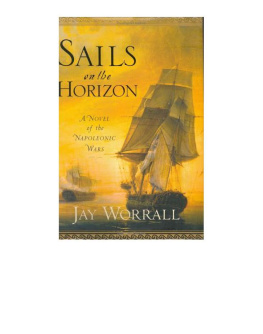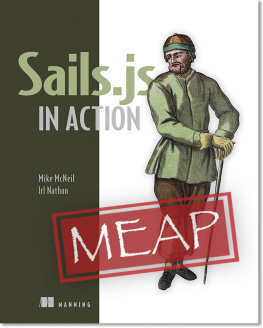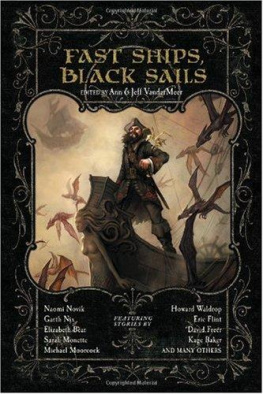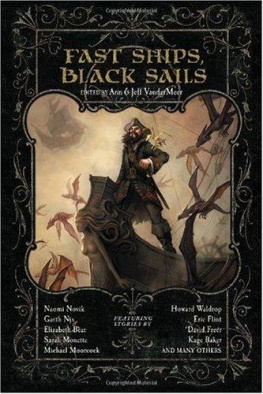Jay Worrall - Sails on the Horizon
Here you can read online Jay Worrall - Sails on the Horizon full text of the book (entire story) in english for free. Download pdf and epub, get meaning, cover and reviews about this ebook. year: 2006, publisher: Random House, genre: Science. Description of the work, (preface) as well as reviews are available. Best literature library LitArk.com created for fans of good reading and offers a wide selection of genres:
Romance novel
Science fiction
Adventure
Detective
Science
History
Home and family
Prose
Art
Politics
Computer
Non-fiction
Religion
Business
Children
Humor
Choose a favorite category and find really read worthwhile books. Enjoy immersion in the world of imagination, feel the emotions of the characters or learn something new for yourself, make an fascinating discovery.
- Book:Sails on the Horizon
- Author:
- Publisher:Random House
- Genre:
- Year:2006
- Rating:4 / 5
- Favourites:Add to favourites
- Your mark:
- 80
- 1
- 2
- 3
- 4
- 5
Sails on the Horizon: summary, description and annotation
We offer to read an annotation, description, summary or preface (depends on what the author of the book "Sails on the Horizon" wrote himself). If you haven't found the necessary information about the book — write in the comments, we will try to find it.
Sails on the Horizon — read online for free the complete book (whole text) full work
Below is the text of the book, divided by pages. System saving the place of the last page read, allows you to conveniently read the book "Sails on the Horizon" online for free, without having to search again every time where you left off. Put a bookmark, and you can go to the page where you finished reading at any time.
Font size:
Interval:
Bookmark:


This is a work of fiction. Though some characters, incidents, and dialogue are based on the historical record, the work as a whole is a product of the authors imagination.
2006 Random House Trade Paperback Edition
Copyright 2005 by Jay Worrall
All rights reserved.
Published in the United States by Random House Trade Paperbacks, an imprint of The Random House Publishing Group, a division of Random House, Inc., New York.
R ANDOM H OUSE T RADE P APERBACKS and colophon are trademarks of Random House, Inc.
Library of Congress Cataloging-in-Publication Data
Worrall, Jay.
Sails on the horizon : a novel of the Napoleonic Wars / Jay Worrall.
p. cm.
eISBN-13: 978-1-58836-514-9
eISBN-10: 1-58836-514-X
1. First Coalition, War of the, 17921797Naval operationsFiction. 2. Great BritainHistory, Naval18th centuryFiction. 3. Great Britain. Royal NavyOfficersFiction. 4. Quaker womenFiction. 5. Farm lifeFiction. 6. EnglandFiction. I. Title.
PS3623.O77S35 2005
813'.6dc22 2004052033
www.atrandom.com
v1.0
Contents
To Chel Avery
FOREWORD
T HE ERA OFTEN THOUGHT OF AS THE NAPOLEONIC WARS covers a period of roughly twenty-two years, from February , 1793 , when Revolutionary France declared war on Britain, to June , 1815 , the Battle of Waterloo. This was a titanic strugglearguably the first worldwide warbetween France, western Europes most populous country, and Great Britain, the worlds richest. Napoleon Bonaparte, whose personality and abilities came to dominate the period, does not become a prominent figure until about 1799 .
It has often been said that this was a strangely unbalanced conflict: England paramount (though not unchallenged) on the seas; France an almost unrivaled land-based military force. In order for the French army to subdue Britain it had, of course, to cross the English Channel. In order to cross the Channel, France had to at least temporarily neutralize His Majesty George the Thirds Royal Navy. To accomplish this, she would require the assistance of such other naval forces as were available from Spain, Denmark, and Holland.
Numerous nations and their colonial possessions were allied with one side or the other, not infrequently changing allegiances as a result of conquest, coercion, or choice. Of particular interest is Spain; a nominal ally of Britain at the outset of the conflict, she came under the dominion of France and switched sides in October 1796 . This is important because, on paper, the Spanish possessed a powerful navy that if allowed to combine with the remnants of once-significant French naval forces would present very serious strategic problems to London. Thus on the morning of February , 1797 , a Spanish fleet of about twenty-seven sail of the line is to be found sailing from Cdiz for the purpose of joining with the French at the port of Brest.
A NOTE ON
MEASUREMENTS AND VALUES
Money
IT IS NOT POSSIBLE TO DIRECTLY EQUATE THE PURCHASING power of currency between the late eighteenth and early twenty-first centuries. It has been suggested, however, that the value of an English pound in 1790 might be multiplied by a factor of seventy or eighty to give an approximate year- 2000 equivalent. From pounds to American dollars the ratio might be : or . English pounds were divided into shillings, pennies, and farthings: twenty shillings to a pound; twelve pennies to a shilling; four farthings to a penny. A loaf of bread cost about four pence.
Distance
Units of measurement for distance at sea were not always standardized. The author has used:
league = nautical miles = . kilometers nautical mile = , feet (. statute miles) = . kilometers cable length = about yards (/ of a league) = meters fathom = feet (/ of a league) = . metersTime on British naval ships was measured in watches and bells. The day officially began at noon and was divided into seven watches, five of four hours each and two of two hours:
Afternoon: | noon to P . M . |
st Dog: | P . M . to P . M . |
nd Dog: | P . M . to P . M . |
First: | P . M . to midnight |
Middle: | midnight to A . M . |
Morning: | A . M . to A . M . |
Forenoon: | A . M . to noon |
The ships bell was rung in cumulative half-hourly intervals during each watch, so that three bells in the afternoon watch is : P . M . and four bells in the middle watch is A . M .
ONE
St. Valentines Day, 1797
Eight leagues southwest of
Cape St. Vincent, Portugal
T HE F-FLAGSHIPS SIGNALING AGAIN, SIR. ENGAGE THE enemy, I think it says. The adolescent midshipman stood in an oversized jacket and flapping trousers at the top of the forward ladderway, squinting into the distance along the line of British warships, each laboring more or less one cables length behind the other, pointed toward a gap between two large Spanish squadrons. He fairly danced with excitement.
Thank you, Mr. Bowles. You may come down now, said Charles Edgemont, the second lieutenant aboard His Britannic Majestys sixty-four-gun ship of the line Argonaut . At twenty-five, Edgemonts career in the navy had already spanned thirteen years, seven as a midshipman himself and six as a commission officer. His responsibility with the ship at quarters was the upper gundeck and its twenty-eight brightly painted black twelve-pounder cannon, neatly aligned on their carriages, fourteen to a side. The smallish and outdated Argonaut , captained by Sir Edward Wood, had taken her position as the last in the nearly mile-long fifteen-ship English line. Charles had watched as the fleet arranged itself into formation earlier in the morning and knew the order of battle. Leading the van was Culloden, seventy-four guns, under Captain Thomas Troubridge, and then the Blenheim and the Prince George, both grand ninety-eights. The flagship, Victory, with its hundred guns and Admiral Sir John Jervis, took station seventh in the line, near the center. The fleet sailed on an easy gray sea, through intermittent gray mist, under gray skies with a chill wind blowing steadily if moderately from the west. The Argonaut s crew had long since been ordered to quarters, the sails shortened, the topgallant masts struck down, and the courses brailed up in preparation for battle. Sand had been scattered on the wetted decks to improve footing and reduce the chance of fire. The guns were charged, double-shotted, primed, and run out, each of their six-man crews standing anxiously beside them.
My G-God, theres a lot of em, Bowles reported, his voice breaking. There must be near a score in the group awindward. Tother bunch alee aint but about half that large. Billy Bowles was fourteen, a pimply youth with sallow skin and unruly hair, assigned to the gundeck. Charles had taken a liking to the boy but thought him too tender for a life in the navy. He was easily bullied by his messmates in the gun room and Charles had come across him bruised and reduced to tears more than once. The Culloden s almost up to them, the boy bubbled on. Cant be more than a mile and a half afar.
Come down from that ladder and take your station, Charles said. Well be up to them soon enough.
I see a four-decker, sir, and a bunch of three-deckers! Oh, my God.
Next pageFont size:
Interval:
Bookmark:
Similar books «Sails on the Horizon»
Look at similar books to Sails on the Horizon. We have selected literature similar in name and meaning in the hope of providing readers with more options to find new, interesting, not yet read works.
Discussion, reviews of the book Sails on the Horizon and just readers' own opinions. Leave your comments, write what you think about the work, its meaning or the main characters. Specify what exactly you liked and what you didn't like, and why you think so.












